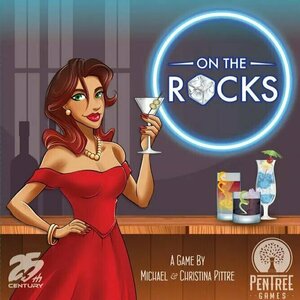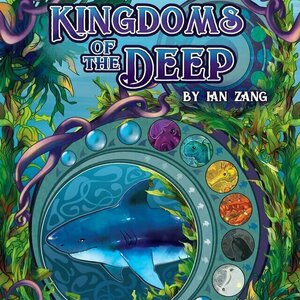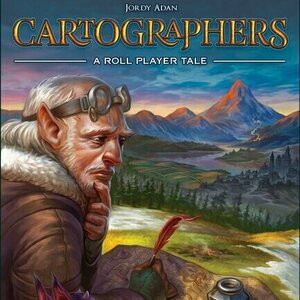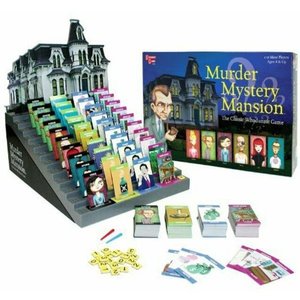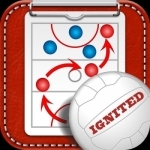
Great Coach Netball
Sports and Productivity
App
Give your team the winning edge with better planning, interchange, scoring, stats and more. Designed...
Purple Phoenix Games (2266 KP) rated On the Rocks in Tabletop Games
Sep 7, 2021
“On the Rocks is a marble drafting, cocktail recipe fulfillment game for 1-4 players. It is NOT a drinking game.” – straight from the game’s BGG page. So what does that mean? Well, this one is a variation of the “I cut, you choose” style game, but HEAVILY themed around bartending and enhanced with additional fun mechanics. The winner is the player who amasses the most amount of money by the end of their shift.
DISCLAIMER: We were provided a copy of this game for the purposes of this review. This is a retail copy of the game, so what you see in these photos is exactly what would be received in your box. I do not intend to cover every single rule included in the rulebook, but will describe the overall game flow and major rule set so that our readers may get a sense of how the game plays. For more in depth rules, you may purchase a copy online or from your FLGS. -T
To setup, consult the rulebook, as there are many steps. However, once setup, the game should look similar to the photo below. Choose the starting player and the mixology competition can begin!
On the Rocks is played over several rounds with each player completing specific steps. The first step is optional, and is Tip Cards. Players will accumulate Tip Cards throughout the game, and each one features a special ability that may be used at this time. The next step may also be optional, depending on if the active player had received a Complaint card previously. Complaints must be completed on this step and is pretty much a wrench thrown in the plans by competitors.
Once these (possibly) optional steps have been completed the active player then takes the 2d6 and Rolls them. This number determines how many ingredient marbles are to be pulled from the bag and added into play. For the cost of one ingredient marble, the active player may manipulate the rolled dice by flipping it to its opposite face. Next, the player will Draft the number of marbles from the bag they rolled in the previous step. From these drafted marbles the player will Mix them into the blue Jigger Bowls in the middle of the table one at a time, a la Mancala (oh that’s fun to say: A LA MANCALA!). Then the player will Select & Place a jigger of marbles from the table onto their player board. Placing the corresponding marbles onto the drinks is how recipes can be completed. If any ingredients were selected from the jigger but not placed, the player must then place the ingredients into the Extra Ingredients shot glasses on the top portion of the player board, to Save for later use.
When the ingredient marbles have been placed and saved, the player must then complete the Resolve step. Several ingredient marbles are “Premium” or “Spill” marbles. Premium marbles (golden) allow the player to select ANY two ingredients from the draw bag and the Premium marble is then discarded to the coaster in the middle of the table. The black Spill marble forces the active player to draw a Spill card from the deck and complete its action. It also during the Resolve step that the player may complete a recipe card by discarding the drink’s ingredients to the bag and flipping its recipe card face-down. If the entire order (all of the face-up recipe cards) is completed, the active player’s round ends and they notate this by placing one of the three lemon tokens on their player board. Some round end cleanup is performed, like drawing another set of 3 or 4 drink recipes for an order, and the player’s turn is over.
Once a player has completed their third order of drinks, they must indicate “Last Call” to the other players at the table. This informs the other players that they have one last turn to earn any extra money before the game ends. When the game has been finished, final scoring is performed and the winner is they who earned the most money throughout the night. The other players must immediately fix the winner a drink, or buy the winner a shot. Okay, those aren’t in the rulebook, but merely suggestions for the revised second edition…
Components. For those that follow our reviews, you know I am a sucker for games with great components, and this one definitely delivers for me. The aesthetics and art style are just perfect, the double-layer boards are always lovely, and the rubber jiggers are excellent. I cannot see anything that can be improved in terms of components, and I completely expected that because this was published by Pentree Games and 25th Century Games (one of my favorite publishers in the business). The game looks and feels deluxe, which is VERY satisfying.
I think that the Pittre duo of Michael and Christina really knocked it out of the park with this one. Wait, this is their first game design?? And it’s incredible? Okay okay, I’ll be keeping my eye on you two. On the Rocks is a light game with excellent table presence and some difficult choices presented. Now, the choices may be TOOOOOO difficult for some gamers, especially our AP-prone players. Carefully planning out each ingredient’s distribution into the jigger bowls can send them into a frenzy, so I have advised to choose one or two bowls they wish to buff and concentrate on hitting those with the marbles they want, and just randomly place the other ingredients. I know that is a big ask, but this game is supposed to take 45-90 minutes, not 45-90 hours. My other gripe about the game is the color-dependence of the ingredient marbles. I am sorry to all my colorblind friends out there, but I am unable to see how you might keep a possible 12 different marbles straight in your heads while simultaneously remembering the state of marbles in each jigger bowl. I hope I am completely wrong, as I do not suffer from colorblindness, and please do let me know if this is still playable for those gamers.
These gripes aside, everything else about the game is fabulous. I love being able to manipulate my dice rolls (yes, with a cost) to have ultimate control of the number of marbles pulled from the bag. That bag, however, takes control away immediately unless I draft a bunch of clear (wild) or golden marbles to affect my final placements. I also adore struggling to choose which recipes to concentrate on first, and weighing the possibilities of completing the higher value recipes, or blitzing the smaller ones first.
Oh, and the Spills cards? They can be real pains in the booty. These effectively give the active player the ability to completely botch another players’ plans by discarding their ingredient marbles from their player board. Not enough player interaction? How about negative Tip cards, which are earned by completing a recipe, that impede a competitor’s progress by making them complete the Tip card before being able to move on with their plans, or by limiting their marble selection to two instead of the entire bowl? Yeah, this has player interaction for sure.
Again, I like a good drink now and then, just as much as the next person. However, I have never been a bartender, and I do not plan on ever becoming one. I could not ever imagine having to compete with other bartenders for tip money either, especially if it is as brutally cutthroat as On the Rocks portrays it to be. I will, however, play a game where all that “fun” is diluted to dice, cards, and marbles. I was looking through my collection recently and noticed have embarrassingly few games with an adult beverage theme. If you are like me and require more games depicting fun with alcohol, then I strongly urge you to check out On the Rocks. I feel like I can finally graduate from Fuzzy Navels and Stone Sours just by playing this game and really upping my liquor acumen. Purple Phoenix Games gives this one a delicious 5 / 6. It seems readily available for consumption, but please do not try to go drink for drink with this game. It’s not designed to be a drinking game… or is it?
Purple Phoenix Games (2266 KP) rated Kingdoms of the Deep in Tabletop Games
Dec 26, 2020
Kingdoms of the Deep is an abstracted area-control game set in the ocean for one to six players. In it players lead a faction of creatures intent on ruling the underwater kingdom. The player who scores the most VP at the end of the game is the winner, and as their king the player must rule with a strong pectoral fin. Okay, that last part isn’t in the rules, but it should be.
DISCLAIMER: We were provided a prototype copy of this game for the purposes of this preview. These are preview copy components, and the final components may be different from these shown. Also, it is not my intention to detail every rule in the game, but to give our readers an idea of how the game plays. You are invited to back the game on Kickstarter launching January 12, 2021, order from your FLGS, or purchase through any retailers stocking it after it is fulfilled. -T
To setup players will choose a color and take all components of that color. Obviously, the best choice is purple. Next the central board will be built of large hex tiles surrounding an Atlantis tile. Upon Atlantis one Shark token will be placed. The Score Board is placed near the central hex board and upon it is placed the Round Marker, the End Game Scoring tile, and the three Goal cards. Players then populate the board with their Influence Cubes on their specific preferred terrain types. Upgrade Cubes (discs in the final version) are then placed on each player’s individual play mats on the furthest value to the left, save for the Reset upgrades: players will choose one to place a cube. Give the starting player the Start Player token (a manta ray in this prototype) and the game may begin!
On a turn each player will choose a card from their hand of Action cards to be flipped simultaneously. The starting player will resolve their card first and play will continue around the table thenceforth. Each player will take their action and prepare for the next round. Should a player choose a card that no other player had chosen for the round they will also be able to activate the Solo Ability printed on the card. Typically these Solo Abilities are a furtherance of the action chosen. For example, should a player choose the Deploy Action card and be the only one to do so, they will be able to deploy one additional Influence Cube on the board than normal. The actions are Bolster, Deploy, Move, Upgrade, Shark, and Reset. Each action is limited to a number of cubes added, spaces moved, or upgrades allowed according to where the player board discs (large cubes in the prototype) lie on the player’s mat.
The Bolster action allows the player to add a number of Influence Cubes to the board on the player’s current preferred terrain type. To Deploy units is to add Influence Cubes to the board on hexes already containing their Influence or hexes directly adjacent to those already containing their Influence cubes. When a player chooses the Move action they are able to move creatures (Influence Cubes of any player and Shark tokens) a number of spaces that can be used for once creature or split between several. Players will certainly wish to Upgrade their actions throughout the game by increasing their player board discs’ spaces on their mat. For example, upgrading the Move action could allow the player to move creatures three spaces instead of two. The Shark action allows the player to move the Shark token(s) and chomp creatures on the same hex. Once a Shark feeds, the controlling player will increase their standing on their own Bait Pile track on their play mat. Certain increments on this track will provide the player with one instance of an action (Move, Deploy, etc), and the creature’s Influence Cube is returned to the matching player. Reset actions allow the player to recall their played Action cards to their hands, but also provide whichever action the player originally chose at setup. Should a player wish to Upgrade their Reset action more actions will become available to them each time they utilize the Reset action. Additionally, at the end of the player’s turn having used the Reset action card the Round Marker token is moved one space closer to the end of the game on its track. More on this later.
During play, some creatures may be moved onto the Atlantis tile in the middle of the board via the Deploy or Move actions. When this happens the player who moved the cube onto the Atlantis tile will score a point immediately, and the creature cube is placed in the Atlantis castle (cloth bag in the prototype, but a castle component in the final version). At the end of the game points are awarded to the player with the most creatures in Atlantis.
Every three movements of the Round Marker token signifies a scoring round takes place. Players will consult the current Goal card for any scoring round bonuses and points are earned. The Goal card is then discarded to reveal the next Goal card in sequence on which players can concentrate during the next rounds of play. Also during the first two of these scoring rounds another Shark token is added to the board on the Atlantis tile to be moved around seeking lunch. Once the Round Marker reaches the final scoring round the game ends and points are tallied to arrive at the winner.
Components. Again, this is a prototype version of the game, and while I know certain things will be different in the final version, I do not know what else may be upgraded as a result of any stretch goals reached. Therefore I do not want to comment on the quality of the components, but rather the art style and direction this game is heading toward actual production.
The art on this one is simply gorgeous. The style is the same as that of Animal Kingdoms, which is also a release from Galactic Raptor. All the art I have seen in this game is sublime and permeates the theme into every portion of the game. It is so beautifully colorful and the creatures are all unique and interesting that it may be difficult to concentrate on the actual game for some people, I imagine.
All that aside, I really do think this is a good game. It certainly gives me the Witch’s Brew/Broom Service vibe with benefits for the player who chooses something the others have not. Combine that feeling with that of the chaos of Survive!: Escape from Atlantis area control of constantly-shifting cube placement and I think Galactic Raptor has a hit here. Again, I am excited to see the final product with the more premium components and tweaked rules, but what I have here is still a good implementation of the mechanics with a hard-to-beat theme.
I do quite like the Shark ability to chomp not only everyone else’s creatures, but also your own to take those cubes back into your supply to be Bolstered or Deployed elsewhere. I also really like being able to Upgrade any action I wish to truly personalize my style and tactics during play. I like being able to Move other players’ creatures into Atlantis for that immediate point, but also to remove that cube from play altogether. It creates quite an interesting dynamic and strategy to facilitate other players’ majority status in Atlantis in order to gain quick points and board control right away. There are so many thing to like about this game, and I am so glad I was able to give it a chance on the table.
If you enjoy games similar to those I mentioned previously, then check out Kingdoms of the Deep. It is beautiful, offers quite a bit of strategy and tactics, and stands to become an excellent mid-weight simultaneous action, area control game WITH SHARKS. While I probably won’t be playing this one every game night, I can certainly see myself introducing it to many of my fellow gamers. I urge you to check out the Kickstarter campaign for Kingdoms of the Deep once it launches in January. Tell ’em Old Travis sent ya.

Podomatic Podcast Player - Podcasts & DJ Mixes
Music and Entertainment
App
Tune in to the world's largest community of podcasters and DJs with the Podomatic podcast player!...
Purple Phoenix Games (2266 KP) rated Cartographers: A Roll Player Tale in Tabletop Games
Sep 13, 2021
Cartographers is a flip-and-write style game where players are competing to gain the queen’s favor and become the royal cartographer. While the main game focuses on finishing with a greater score than your opponent(s) the solo game is more relaxed. The solo player will be competing against their previous scores and comparing against the queen’s title matrix. Each game will be played over four seasons (rounds) and once the year is over the winner or title is claimed. Can you score 30 or more points to become a “Legendary Cartographer?”
To setup, lay out the Queen’s Edict cards that show A, B, C, and D. Shuffle each small deck of like-backed Scoring Cards and randomly place one from each deck underneath the Edict cards. Remove all the enemy Ambush Cards and shuffle one into the main deck of Explore Cards. Set the Season Cards in order: Spring, Summer, Fall, and Winter. Each player will receive one Map Sheet and a pencil. The game may now begin!
Each Season Card will feature a time threshold number that when met or exceeded will end the season. This corresponds to the time markings on each Explore Card drawn from the deck. For example, Spring allows 8 measures of time before it will switch to Summer. Explore Cards will usually show from 0-2 time measures on it, so seasons could change after four or more cards. At the start of each season, the player will flip an Explore Card to reveal which type of map element is requested and of which shape. The map elements are Forest, Farm, Water, Village, Mountain, and Monster. The shapes shown on the cards are reminiscent of Tetris-style shapes and also some others as well.
Once a card has been revealed, the player now will draw on their sheet the shape (or one of the shapes if more than one are shown) and fill it in with the matching symbol for map element type. If during this phase of the round the player surrounds the four sides of a pre-printed Mountain square they will score one coin and mark it at the bottom of their Map Sheet.
Should a Ruins card be revealed the player will flip another card to reveal the next card in line. Whatever shape and element is shown on the card AFTER the Ruins card will be used, with a twist. The shape shown on this card will now be required to encompass one of the pre-printed Ruins squares on the Map Sheet. If there are no legal spaces to place these shapes (or any shape on future cards) the player will be allowed to place a single 1×1 square on their Map Sheet anywhere they wish.
Should an enemy Ambush card be revealed the player will check which corner of the map the ambush takes place and will draw the provided monster shape in the closest area to the corner as possible. These are awarded negative points at the end of the seasons and can make large impacts on final scores.
After the elements have been drawn on the Map Sheet the player will check if the season ends. The season will end if the total number of revealed cards’ time measures equal or exceed the time printed on the Season Card (again, for example, Spring lasts 8 time). If not, then the player resumes another card reveal. If the time threshold has been met or exceeded then the player will score for the season by referencing the Scoring Cards that were placed under the Edicts at setup. For Spring the player scores Edict Cards A and B. Mark the score in the space provided at the bottom of the Scoring Sheet and flip the Season Card to the next season to begin a new round.
Play continues in this fashion until all four seasons have been played. At the end of the fourth season the game ends and the player will tally up their score to compare against the queen’s title matrix at the back of the rulebook. Not to brag, but my first game scored over 30 points, so I began this journey as a Legendary Cartographer.
Components. This game is 100 double-sided Map Sheets, four golf pencils, and a bunch of cards. The sheets and pencils are just fine, and the cards are good quality. What I really enjoy about the components is that this is “A Roll Player Tale,” meaning that many of the components and art hearken back to the original Roll Player game. As I love Roll Player’s art style, I also love that of Cartographers. There isn’t a ton of art in the game, more of graphic design, the art that IS provided is stellar Roll Player fare. I have no complaints about the components here except my wife thinks the pencil erasers could be better.
I skipped backing this one on Kickstarter and have only recently come to acquire it. I am definitely kicking myself in the rear for that decision because this is an excellent game. Obviously, anything that is enjoyable solo AND multiplayer is a huge boon (my wife scored it a 5!), and being able to play it multiple times in a row is a benefit as well.
We both love the decision-making in Cartographers, and when we first played together I had to shield my map sheet from my wife because she was copying! SHE was copying ME! She ended up handing me my booty in that game (of course) but we both had a great time plotting out our map elements. Determining where and which direction a shape should be placed can certainly be frustrating, but seeing your well-laid plans come to life is very rewarding. I am definitely seeing myself needing to download and print off more map sheets in the future because I have a feeling I am going to be playing the mess out of this one.
If you are looking for something special for your collection, check out Cartographers. If you already enjoy Roll Player, this will feel homey to you while offering a completely different style of game. My wife and I love it, and I am not sure I know anyone who would turn their nose up at it. Once we get into the Post-COVID era I plan to play this all the time at game nights.

Strife: Legacy of the Eternals
Tabletop Game
Once more, conflict rages across the world of Aerim. You are one of the Eternals, a group of...

Cooking Customers
Tabletop Game
Play cards, roll dice and don't get fired! In Cooking Customers you will need to hire cooks to...

Bob Ross: Art of Chill Game
Tabletop Game
If you want to paint with Bob Ross, you need to be chill, so whoever reaches maximum chill first in...
Dean (6927 KP) rated Murder Mystery Mansion in Tabletop Games
Mar 29, 2018 (Updated Mar 29, 2018)
The other player has so many steps to guess all four right. There are only about 6 choices for each category to choose from. For a longer game I think you can say the person has so many of the 4 guesses right without saying which. Given the title I hoped for more than a guessing game.

How to Watch Football
Book
How can one striker be better than three? Why do the best defenders never need to make a tackle?...
